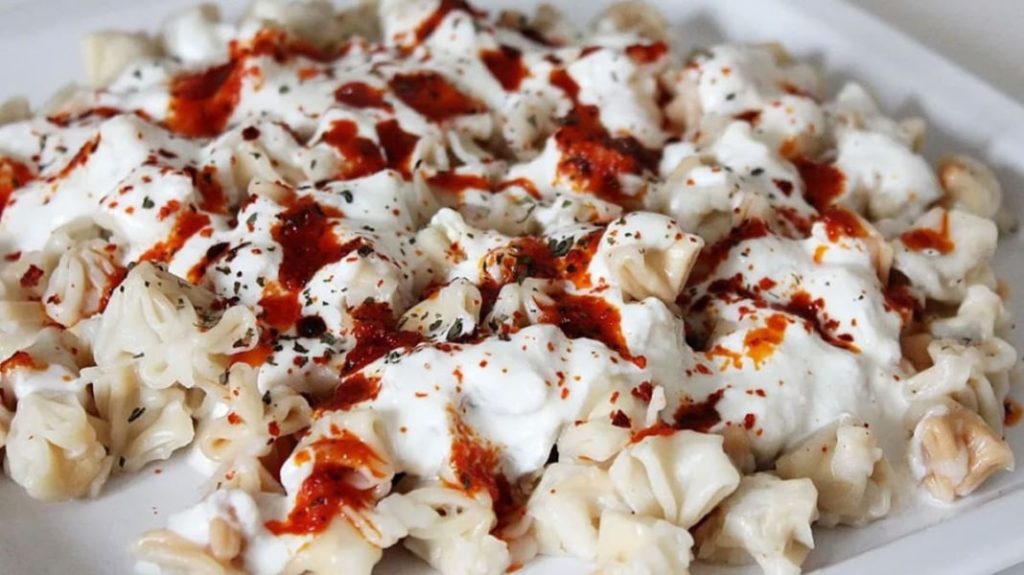The word mantı derives from mantu, meaning dumplings. The dumplings typically consist of a spiced meat mixture, usually lamb or ground beef, in a thin dough wrapper and either boiled or steamed. Mantı is traditionally served with a garlicky yoghurt sauce and a red pepper or tomato sauce.
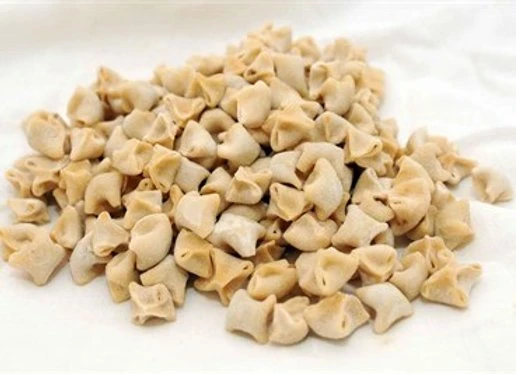

The origin is somewhat uncertain, it is thought that the dish may have originated in the territories of the Mongol Empire. Some variations may be traced back to the Uyghur people of northwest China. One of the earliest mentions of manta is found in the 1330 manuscript Yinshan Zhengyao by Hu Sihui, a court therapist in service of the Yuan Dynasty.
It is a shared culinary heritage that the nomadic Turkish tribes brought with them when they travelled from Central Asia towards Anatolia, today’s Türkiye, during the 13th century. According to author Holly Chase, “Turkic and Mongol horsemen on the move were supposed to have carried frozen or dried mantı, which could be quickly boiled over a campfire”
Migrating Turkic-speaking peoples brought the dumpling with them to Anatolia, where it evolved into the Turkish mantı. When the Tatars settled into the central Kayseri region of modern-day Türkiye, the area became known for its Kayseri mantısı.
Kayseri mantısı
Kayseri mantısı is tiny and served with yoghurt, melted butter flavoured with Aleppo pepper, dried mint and seasoning, In Kayseri, when a couple is engaged to be married, the mother of the groom visits the bride’s house and during this visit, the bride should prepare mantı for her prospective mother-in-law. The smaller the mantı dumplings are, the more skilful the bride is considered to be in the kitchen. Traditionally the dumplings prepared for the prospective mother-in-law are supposed to be so small that 40 of them can fit into one spoon.
Mantı may be made from shredded meat of quail, chicken or goose in some regions of Türkiye, while boş mantı (“empty dumpling”) lacks filling entirely.
Turkish cuisine includes also other dumplings similar to mantı, such as hingel and Tatar böreği. These are typically larger than Kayseri mantısı.
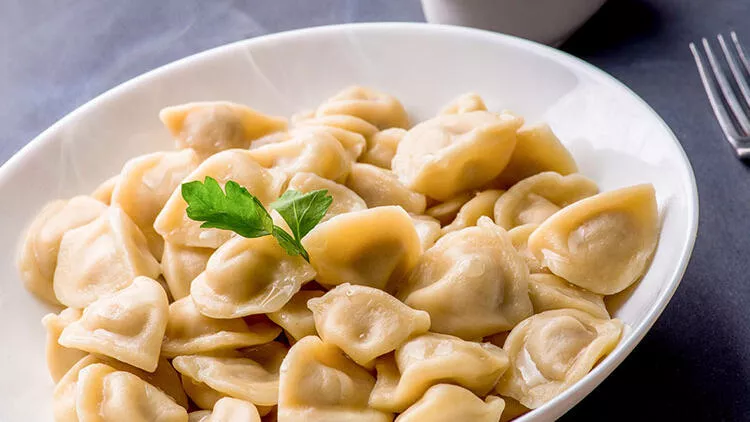
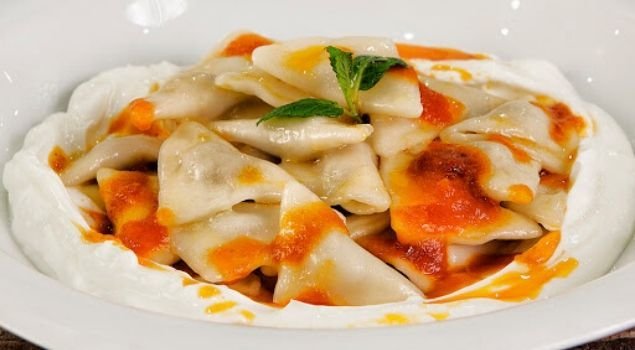
How to make Turkish mantı
Although you can easily find mantı in shops and supermarkets, there’s nothing quite like having a go at making your own. Here’s a recipe from Ozlem’s Turkish Table.
Mantı, Turkish dumplings with ground meat, onion and spices
Serves 4 people
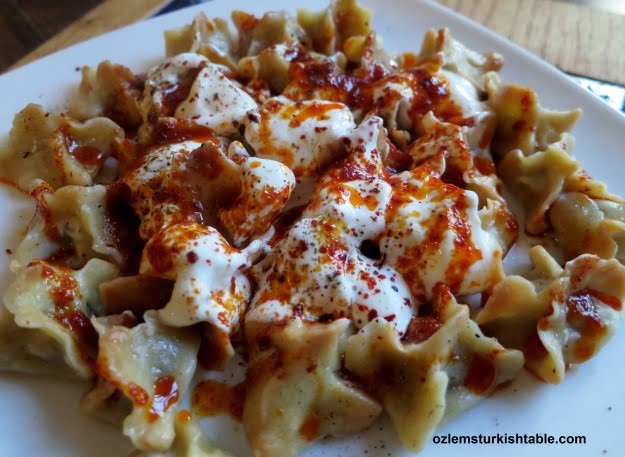
Dough ingredients:
300gr/ 2 cups/ 10 ½ oz. all-purpose plain flour (plus a little extra for rolling)
1 egg, beaten
4 fl. oz. / ¼ cup water
30ml/2 tbsp. olive oil
5ml/1 tsp sea salt
For the filling:
225gr/8oz ground beef or lean ground lamb
1 onion, grated or very finely chopped
Salt and freshly ground black pepper
For the garlic yoghurt:
500gr/2 ¼ cups thick and creamy plain yoghurt
1 -2 garlic cloves, crushed and finely chopped
Salt to taste
For the sauce:
15ml/1 tbsp. Turkish hot pepper paste, (biber salcası) or tomato paste
60ml/4 tbsp. olive oil
10 ml/2 tsp. dried mint (kuru nane)
5 ml/1 tsp. (or more) ground sumac (optional)
5 ml/ 1 tsp. (or more) Turkish red pepper flakes (chilli flakes, pul biber)
Method
Preheat the oven to 180 C / 350 F
First, make the dough. Sift the flour and salt into a wide bowl and make a well in the middle. Pour in the beaten egg and the water and using your hands, draw the flour into the liquid and mix into a dough. Pour in the olive oil and knead the dough for about 5-8 minutes, until it is smooth and elastic. Mantı dough needs to be quite hard; cover the dough with a cling film or kitchen towel and leave it to rest in a cold place or in the fridge for 30 minutes.
While the dough is resting, make the filling. Grate or finely chop the onion and combine it with the ground meat. Season with salt and ground black pepper and mix well.
In a separate bowl, beat the yoghurt with the garlic and season with salt to your taste.
Cut the dough into 3 pieces. Working one piece of dough at a time (and cover the rest of the dough pieces with a damp towel in the meantime so they don’t dry out), roll the dough as thinly as you can into a sheet, on a lightly floured surface. Using a sharp knife, cut the dough into small squares (roughly 2.5cm/1in). Spoon a little of the filling, rounded at a size of half a chickpea, into the middle of each square.
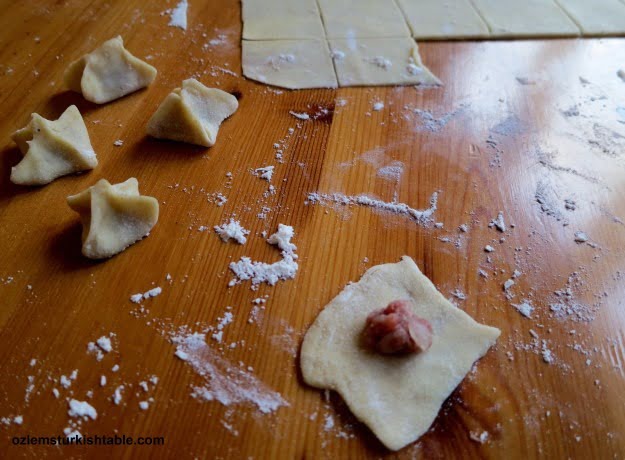
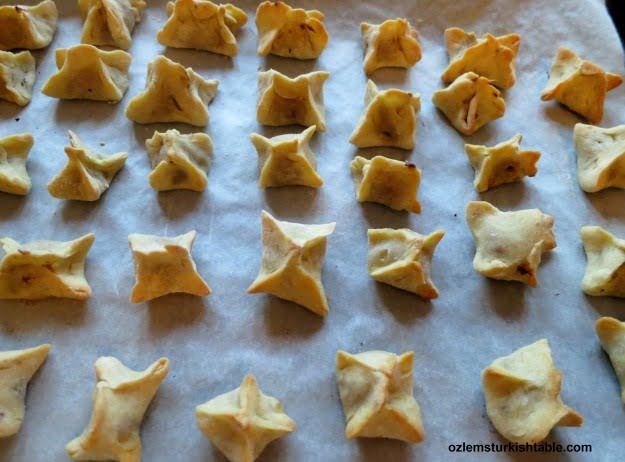
Pinch the opposite corners to form a little pouch and press the seams together to seal firmly.
Bake uncovered for 10 minutes until the mantı dumplings start to get light golden.
Repeat with the rest of the dough and place the stuffed dumplings in a greased oven-proof dish, stacking them next to one another. Bake uncovered for 10 minutes until the mantı starts to get light golden. Take them out of the oven and cool them. You can freeze some of the baked mantı in a sealed bag for up to 3 weeks.
Pour the hot water and pinch of salt into a large pan and bring to a boil. Place the baked dumplings gently into the boiling water and simmer for about 8- 10 minutes, until they are cooked. Once cooked, drain the water and return the mantı to the pan. Drizzle a little oil over them so that they don’t stick together.
While mantı is cooking, prepare your sauce. Heat the oil in a wide pan and add the hot pepper paste, biber salcasi or tomato paste. Stir in the red pepper flakes, dried mint and sumac, combine well and simmer for 1-2 minutes.
Arrange mantı on a warm serving dish and spoon the garlic yoghurt over them. Drizzle spices-infused olive oil and tomato/red pepper paste sauce over the garlic yoghurt. You can decorate with extra red pepper flakes, dried mint and sumac and serve immediately.
Please follow the link below for Ozlem’s recipe for vegetarian mantı.
Vegetarian mantı, Turkish dumplings with sautéed onions, chickpeas and spices
Afiyet Olsun
Source: Wikipedia/Ozlem’s Turkish Table

